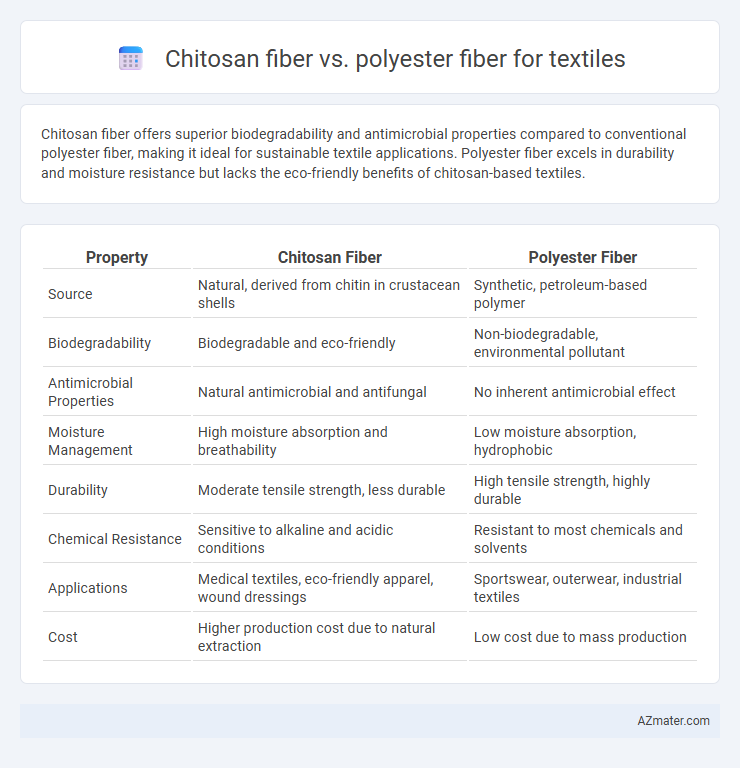Chitosan fiber offers superior biodegradability and antimicrobial properties compared to conventional polyester fiber, making it ideal for sustainable textile applications. Polyester fiber excels in durability and moisture resistance but lacks the eco-friendly benefits of chitosan-based textiles.
Table of Comparison
| Property | Chitosan Fiber | Polyester Fiber |
|---|---|---|
| Source | Natural, derived from chitin in crustacean shells | Synthetic, petroleum-based polymer |
| Biodegradability | Biodegradable and eco-friendly | Non-biodegradable, environmental pollutant |
| Antimicrobial Properties | Natural antimicrobial and antifungal | No inherent antimicrobial effect |
| Moisture Management | High moisture absorption and breathability | Low moisture absorption, hydrophobic |
| Durability | Moderate tensile strength, less durable | High tensile strength, highly durable |
| Chemical Resistance | Sensitive to alkaline and acidic conditions | Resistant to most chemicals and solvents |
| Applications | Medical textiles, eco-friendly apparel, wound dressings | Sportswear, outerwear, industrial textiles |
| Cost | Higher production cost due to natural extraction | Low cost due to mass production |
Introduction to Chitosan and Polyester Fibers
Chitosan fiber, derived from chitin found in crustacean shells, is a biodegradable and antibacterial textile material favored for its eco-friendly properties and skin compatibility. Polyester fiber, a synthetic polymer made from petroleum-based products, dominates the textile industry due to its durability, hydrophobic nature, and cost-effectiveness. Both fibers exhibit distinct applications, with chitosan offering biodegradability and antimicrobial benefits, while polyester provides strength, resilience, and moisture resistance.
Raw Material Sources and Sustainability
Chitosan fiber is derived from chitin, a natural biopolymer obtained primarily from crustacean shells, offering a biodegradable and renewable alternative to traditional fibers. Polyester fiber, synthesized from petrochemical sources such as petroleum and natural gas, relies heavily on non-renewable resources and contributes significantly to microplastic pollution. The sustainability of chitosan fiber is enhanced by its eco-friendly production process and biodegradability, whereas polyester's environmental impact is magnified by its energy-intensive manufacturing and persistent waste accumulation.
Fiber Production Processes
Chitosan fiber is produced through a wet-spinning process where chitosan is dissolved in a dilute acid solution and extruded into a coagulating bath, resulting in biodegradable and antimicrobial fibers. Polyester fiber production involves polymerization of purified terephthalic acid with ethylene glycol, followed by melt spinning to form strong, durable synthetic fibers. The chitosan fiber production emphasizes eco-friendly and renewable materials, while polyester fiber focuses on chemical synthesis and thermal processing for mass production efficiency.
Mechanical Properties Comparison
Chitosan fiber exhibits superior biodegradability and excellent moisture absorption compared to polyester fiber, which is renowned for its high tensile strength and durability. The mechanical properties of chitosan fiber reveal lower elongation at break and moderate tensile strength, making it less resistant to mechanical stress than polyester fiber, which maintains high elasticity and resilience. For textile applications requiring sustainability and comfort, chitosan fibers provide a biodegradable alternative, while polyester fibers dominate in strength and long-term wear resistance.
Moisture Absorption and Breathability
Chitosan fiber exhibits superior moisture absorption due to its hydrophilic nature and porous structure, enabling enhanced sweat-wicking and comfort in textile applications. Polyester fiber, being hydrophobic, has limited moisture absorption, often leading to trapped sweat and reduced breathability. The natural biodegradability and antimicrobial properties of chitosan fibers further enhance breathability and odor control compared to synthetic polyester fabrics.
Biodegradability and Environmental Impact
Chitosan fiber is highly biodegradable, breaking down naturally within months, reducing long-term environmental pollution compared to polyester fiber, which can take centuries to decompose in landfills. The production of chitosan fiber derives from renewable sources such as crustacean shells, promoting waste valorization and lowering carbon emissions, whereas polyester fiber relies on petrochemical processes with significant greenhouse gas output. Textile manufacturers prioritizing sustainability increasingly favor chitosan fibers due to their eco-friendly profile and lower environmental footprint throughout the product lifecycle.
Dyeability and Color Fastness
Chitosan fiber exhibits superior dyeability compared to polyester fiber due to its abundant amino groups, which form strong bonds with reactive and acid dyes, resulting in vibrant and uniform coloration. Polyester fiber, being hydrophobic and chemically inert, requires disperse dyes and high-temperature dyeing processes, often leading to lower dye uptake and less color vibrancy. In terms of color fastness, chitosan fiber demonstrates excellent wash and light fastness owing to its strong dye-fiber interactions, while polyester typically achieves good color fastness but may suffer from reduced performance under prolonged UV exposure.
Antimicrobial and Functional Properties
Chitosan fiber exhibits superior antimicrobial properties compared to polyester fiber, effectively inhibiting the growth of bacteria, fungi, and other pathogens due to its natural biopolymer structure. Its inherent biodegradability and moisture absorption enhance comfort and reduce odor, making it ideal for functional textile applications. Polyester fiber, while durable and moisture-resistant, lacks intrinsic antimicrobial activity and requires chemical treatments to achieve similar functional benefits.
Applications in Textile Industry
Chitosan fiber offers superior antimicrobial properties, biodegradability, and moisture absorption, making it ideal for medical textiles, sportswear, and eco-friendly fashion. Polyester fiber excels in durability, wrinkle resistance, and cost-effectiveness, widely applied in mass-produced apparel, upholstery, and industrial fabrics. The textile industry leverages chitosan for sustainable and functional products, whereas polyester dominates sectors requiring strength and affordability.
Future Trends and Innovations
Chitosan fiber, derived from renewable resources like crustacean shells, offers significant biodegradability and antimicrobial properties, positioning it as a sustainable alternative to conventional polyester fiber in textiles. Innovations in blending chitosan fibers with synthetic polymers are enhancing fabric durability and moisture management, aligning with the growing demand for eco-friendly and functional textiles. Future trends emphasize advanced bio-engineering methods to improve chitosan fiber's scalability and performance, meeting consumer preferences for sustainable, high-performance apparel.

Infographic: Chitosan fiber vs Polyester fiber for Textile
 azmater.com
azmater.com